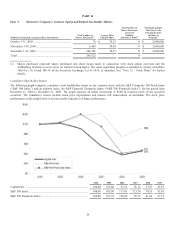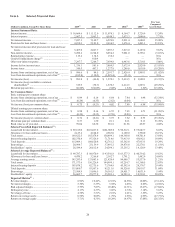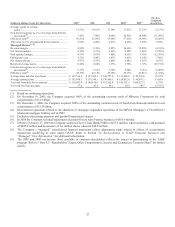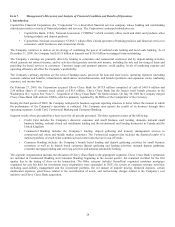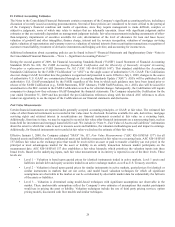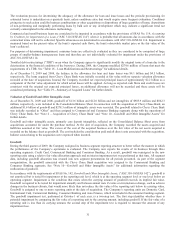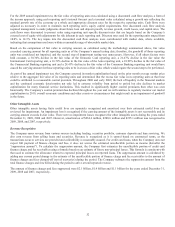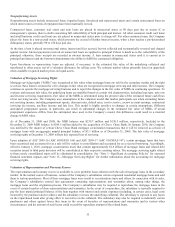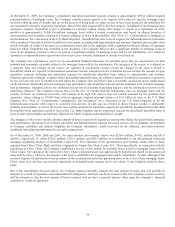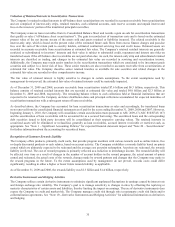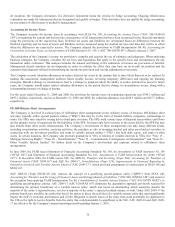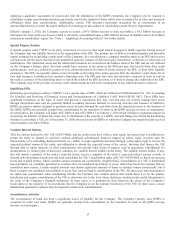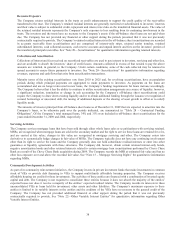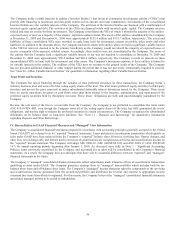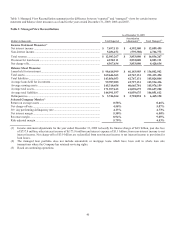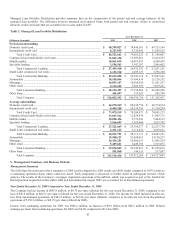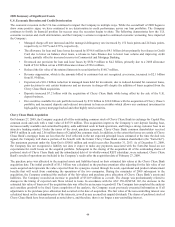Capital One 2009 Annual Report Download - page 47
Download and view the complete annual report
Please find page 47 of the 2009 Capital One annual report below. You can navigate through the pages in the report by either clicking on the pages listed below, or by using the keyword search tool below to find specific information within the annual report. 34
At December 31, 2009, the Company’s subsidiaries had open repurchase requests relating to approximately $966.2 million original
principal balance of mortgage loans. The Company considers open requests to be requests with respect to specific mortgage loans
received within the past 24 months that are in the process of being paid, are under review or have been denied by the subsidiary but
not rescinded by the party requesting repurchase. Most of the open requests fall in this last category. In addition to the foregoing open
repurchase requests, GreenPoint is also a defendant in a lawsuit seeking, among other things, to require it to repurchase an entire
portfolio of approximately 30,000 GreenPoint mortgage loans within a certain securitization trust based on alleged breaches of
representations and warranties relating to a limited sampling of loans in the portfolio. (See “Note 21—Commitments, Contingencies
and Guarantees” for a discussion of the U.S. Bank litigation). GreenPoint has also received requests for indemnification in connection
with a number of lawsuits in which GreenPoint is not a party, including both representation and warranty litigation and securities class
actions brought on behalf of investors in securitization trusts that in the aggregate hold a significant principal balance of mortgage
loans for which GreenPoint was identified as the originator. The Company believes that a significant number of mortgage loans at
issue in the litigations referred to above as well as a significant number of mortgage loans sold by the subsidiaries as to which no
repurchase or indemnification requests have been received are currently delinquent or already foreclosed on.
The Company has established a reserve in its consolidated financial statements for potential losses that are considered to be both
probable and reasonably estimable related to the mortgage loans sold by the subsidiaries. The adequacy of the reserve is evaluated on
a quarterly basis and changes in the reserve are reported in non-interest income, except for changes in the reserve related to
GreenPoint which are reported in discontinued operations. Factors considered in the evaluation process include the amount of open
repurchase requests, including any repurchase requests for specifically identified loans subject to representation and warranty
litigation against the Company or against others demanding indemnification, the estimated amount of additional repurchase requests to
be received over the next 12 months (beyond which the Company does not believe that a reasonable assessment can be made) based
on the historical relationship between mortgage loan performance and repurchase requests and the estimated level of future mortgage
loan performance, litigation activity, the estimated success rate of claimants in pursuing requests, and the estimated recoveries on the
underlying collateral. The Company expects that over the next 12 months both the delinquency rates on mortgage loans and the
severity of losses on collateral recoveries will continue to be high. The reserve does not include amounts for the portfolio-wide
repurchase claim relating to 30,000 loans with an aggregate original principal balance of $1.8 billion at issue in the U.S. Bank
litigation (See “Note 21—Commitments, Contingencies and Guarantees” for a discussion of the U.S. Bank litigation) or for the
indemnification requests with respect to securities class actions, in each case as referred to above because neither is sufficiently
probable and estimable. As noted, the reserve does include amounts for repurchase requests for specifically identified loans (other than
the portfolio-wide repurchase claim) at issue in the U.S. Bank litigation and for repurchase requests for specifically identified loans at
issue in other representation and warranty litigation for which Company indemnification is sought.
The adequacy of the reserve and the ultimate amount of losses incurred will depend on, among other things, the actual future mortgage
loan performance, the actual level of future repurchase and indemnification requests, the actual success rate of claimants, development
in Company subsidiary and industry litigation, the Company subsidiaries’ actual recoveries on the collateral, and macroeconomic
conditions (including unemployment levels and housing prices).
As of December 31, 2009, 2008 and 2007, the representation and warranty reserve was $238.4 million, $140.2 million and $93.4
million, respectively, of which $210.2 million, $122.2 million, and $84.5 million were attributable to the discontinued wholesale
mortgage origination business of GreenPoint, respectively. The remainder of the representation and warranty claims relate to loans
acquired from Chevy Chase Bank and those originated by Capital One Home Loans, LLC. More specifically, in connection with the
acquisition of Chevy Chase, the Company established a reserve of $16 million for potential losses related to mortgage loans sold by
Chevy Chase. The amount of the reserve for Chevy Chase’s potential losses was approximately proportional (based on the amount of
loans sold by Chevy Chase) to the amount of the reserve established for mortgage loans sold by GreenPoint. To date, although it has
received requests for information from an insurer of the securitization trusts that purchased some of the Chevy Chase mortgage loans,
Chevy chase does not have any material repurchase or indemnification requests and is not subject to any litigation related to these
loans.
Due to the uncertainties discussed above, the Company cannot reasonably estimate the total amount of losses that will actually be
incurred as a result of repurchase and indemnification obligations, and there can be no assurance that the Company’s current reserves
will be adequate or that the total amount of losses incurred will not have a material adverse effect upon the Company’s financial
condition or results of operations.


